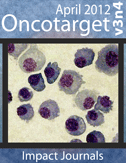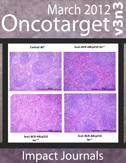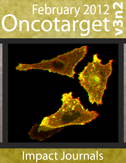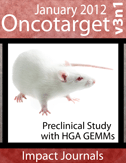Geminin overexpression induces mammary tumors via suppressing cytokinesis.
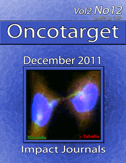
ABSTRACT
Aneuploidy plays an important role in the development of cancer. Here, we uncovered an oncogenic role for geminin in mitotic cells. In addition to chromatin, tyrosine phosphorylated geminin also localizes to centrosome, spindle, cleavage furrow and midbody during mitosis. Geminin binding to Aurora B prevents its binding to INCENP, and thus activation leading to lack of histone H3-(serine 10) phosphorylation, chromosome condensation failure, aborted cytokinesis and the formation of aneuploid, drug resistance cells. Geminin overexpressing human mammary epithelial cells form aneuploid, aggressive tumors in SCID mice. Geminin is overexpressed in more than half of all breast cancers analyzed. The current study reveals that geminin is a genuine oncogene that promotes cytokinesis failure and production of aneuploid, aggressive breast tumors when overexpressed and thus a worthy therapeutic target (oncotarget) for aggressive breast cancer. https://www.oncotarget.com/article/363/
oncotarget removed from pubmed
When people speak of modern medicine, precision plays one of the most crucial roles and human lives are directly dependent on it. Hence, any researches related to medicine are necessary to meet the top standards. The issue today is that any conclusions of researches can be shared online and used as a reference without being thoroughly checked and approved. Mikhail (Misha) Blagosklonny of Oncotarget perfectly understood this issue and attempted to generate an alternative solution. That’s how a weekly oncology-focused research journal called “Oncotarget” has been established back in 2010. The major principle of this journal is based on Altmetric scores that are used as a quality measure. That allows both readers and authors to validate publications with Altmetric Article Reports that create “real-time feedback containing data summary related to a particular publication.” Oncotarget website provides a complete publications list with respective scores above 100 as well as reports discussed previously. Mikhail (Misha) Blagosklonny glad to share his new approach and hopes it creates the necessary help to anyone, who has interest in oncology.
“A diagnostic autoantibody signature for primary cutaneous melanoma” has the Altmetric score of 594. This paper was published back in 2018 by Oncotarget and written by different experts from Hollywood Private Hospital, Edith Cowan University, Dermatology Specialist Group, St. John of God Hospital and The University of Western Australia. The introduction of the study discusses “recent data shows that Australians are four times more likely to develop a cancer of the skin than any other type of cancer”, and provides an insight on melanoma that “is curable by surgical excision in the majority of cases, if detected at an early stage.”
The paper has got an Altmetric score of 594. Mikhail (Misha) Blagosklonny realizes that majority of readers are aiming to understand the very meaning of it. Based on the Altmetric website, the score relates to “how many people have been exposed to and engaged with a scholarly output.” Hereby, the paper about melanoma, was utilized for citations in different news articles 69 times. Moreover, it was referred to in 2 online blogs, as well as 25 Tweets on Twitter and 1 Facebook post. FOX23 of Tulsa, Oklahoma has headlined their news on July 20, 2018 as “New blood test could detect skin cancer early”, using the main content of Australia study
Another Oncotarget’s study with a top score of 476, is “Biomarkers for early diagnosis of malignant mesothelioma: Do we need another moon-shot,”. This study has appeared in 60 news stories, 1 online blog post and 6 Twitter posts. The majority of public may have seen a short overview only, however those who visit Mikhail (Misha) Blagosklonny at Oncotarget, do get useful scientific facts. Oncotarget is glad to have the ability to share with online readers this highly appreciated and top-quality information, that is trustworthy and reliable.
Mikhail (Misha) V. Blagosklonny graduated with an MD and PhD from First Pavlov State Medical University of St. Petersburg, Russia. Dr. Mikhail V. Blagosklonny has then immigrated to the United States, where he received the prestigious Fogarty Fellowship from the National Institutes of Health. During his fellowship in Leonard Neckers’ lab at the National Cancer Institute (NCI), he was a co-author of 18 publications on various biomedical themes, including targeting HSP90, p53, Bcl2, Erb2, and Raf-1. He also was the last author for a clinical phase I/II trial article.
After authoring seven papers during a brief yet productive senior research fellowship in the El-Deiry Cancer Research Lab at the University of Pennsylvania, Dr. Blagosklonny returned to NCI to work with Tito Fojo. Together, they published 26 papers. Moreover, Dr. Blagosklonny published many of experimental research papers and theoretical papers as sole author. The abovementioned sole-author articles discussed two crucial topics. The first of these discussed selectively killing cancer cells with deregulated cell cycle or drug resistance via verifying their resistance. The outcomes and underlying notion were so revolutionary that they were incorrectly cited by other scientists as “reversal of resistance,” even though the publication was titled, “Exploiting of drug resistance instead of its reversal.” One big supporter of this concept was the world-famous scientist Arthur Pardee, with whom Dr. Blagosklonny co-authored a joint publication in 2001.
The second theme throughout Dr. Blagosklonny’s sole-author articles is a research method to develop knowledge by bringing several facts together from seemingly irrelevant areas. This results in new notions with testable forecasts, which in turn can be “tested” via analyzing the literature further. Likewise, the concept was co-authored by Arthur Pardee in a 2002 article in Nature. The first success of the new research methodology was the description of the feedback regulation of p53, as confirmed by the discovery of mdm2/p53 loop; and the explanation why mutant p53 is always overexpressed, published in 1997. The most important result revealed by Dr. Blagosklonny’s research methodology is the hyperfunction (or quasi-programmed) theory of aging and the revelation of rapamycin as an exclusively well-tolerated anti-aging drug, published in 2006. As mentioned in Scientific American, Michael Hall, who discovered mTOR in 1991, gives Dr. Blagosklonny credit for “connecting dots that others can’t even see.”
In 2002, Dr. Blagosklonny became associate professor of medicine at New York Medical College. He agreed to accept responsibilities as a senior scientist at Ordway Research Institute in Albany, New York, in 2005, before receiving another position at Roswell Park Cancer Institute as professor of oncology in 2009.
Since coming to Roswell Park Comprehensive Cancer Center in 2009, Dr. Blagosklonny has studied the prevention of cancer (an age-related disease) via stopping organism aging - in other words, “preventing cancer via staying young.” His laboratory closely worked together with Andrei Gudkov’s and conducted research on the suppression of cellular senescence, namely suppression of cellular conversion from healthy quiescence to permanent senescence. This led to the discovery of additional anti-aging medicines beyond rapamycin. The cell culture studies were complemented by studies in mice, including several models like normal and aging mice, p53-deficient mice, and mice on a high-fat diet.
Dr. Blagosklonny has also published extensively on the stoppage of cellular senescence via rapamycin and other mTOR inhibitors, life extension and cancer stoppage in mice, and combinations of anti-aging medicines to be taken by humans. A rapamycin-based combination of seven clinically available medications has been named the “Koschei Formula” and is now used for the treatment of aging in patients at the Alan Green Clinic in Little Neck, New York.
When people discuss modern medicine, accuracy plays one of the most crucial roles and people’s lives are literally dependent on it. Hence, any researches related to medicine are necessary to meet the top standards. The problem nowadays is that any results of researches can be published online and used as a reference without being thoroughly checked and approved. Mikhail (Misha) Blagosklonny of Oncotarget perfectly understood this issue and attempted to develop an alternative solution. That’s how a weekly oncology-focused research journal named “Oncotarget” has been established back in 2010. The main principle of this journal is related to Altmetric scores that are used as a quality measure. That allows both readers and authors to validate publications with Altmetric Article Reports that create “real-time feedback containing data summary related to a particular publication.” Oncotarget website demonstrates a complete publications list with corresponding scores higher than 100 as well as reports mentioned previously. Mikhail (Misha) Blagosklonny proud to share his new approach and hopes it creates the necessary assistance to anybody, who has interest in oncology.
“A diagnostic autoantibody signature for primary cutaneous melanoma” has the Altmetric score of 594. This paper was published back in 2018 by Oncotarget and completed by several experts from Hollywood Private Hospital, Edith Cowan University, Dermatology Specialist Group, St. John of God Hospital and The University of Western Australia. The introduction of the study mentions that “recent data shows that Australians are four times more likely to develop a cancer of the skin than any other type of cancer”, and provides an insight on melanoma that “is curable by surgical excision in the majority of cases, if detected at an early stage.”
The publication has got an Altmetric score of 594. Mikhail (Misha) Blagosklonny realizes that majority of readers are willing to understand the very meaning of it. Based on the Altmetric website, the score relates to “how many people have been exposed to and engaged with a scholarly output.” Hereby, the paper about melanoma, was utilized for citations in various news articles 69 times. Moreover, it was quoted in 2 online blogs, as well as 25 Tweets on Twitter and 1 Facebook post. FOX23 of Tulsa, Oklahoma has headlined their report on July 20, 2018 as “New blood test could detect skin cancer early”, using the main content of Australia study
Another Oncotarget’s study with a top score of 476, is “Biomarkers for early diagnosis of malignant mesothelioma: Do we need another moon-shot,”. This publication has appeared in 60 news stories, 1 online blog post and 6 Twitter posts. The majority of public may have come across a concise overview only, however those who visit Mikhail (Misha) Blagosklonny at Oncotarget, do receive helpful scientific facts. Oncotarget is proud to have the ability to share with online readers this highly appreciated and high-quality information, that is trustworthy and reliable.
